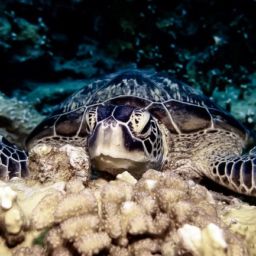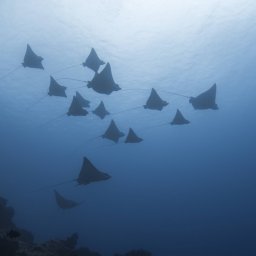Anchor damage on Coral Reefs
Worldwide coral reef faces many threats such as climate change related coral bleaching (Hughes et al., 2017, 2018), nutrient enrichment (Szmant, 2002), crown-of-thorn starfish outbreaks (De’ath et al., 2012). These threaten coral reefs on large spatial scales, e.g. The whole length of the Great Barrier Reef in Australia. In smaller scales other stressors accrue for instance SCUBA diving (Lamb et al., 2014; Tratalos & Austin, 2001). Especially inexperienced divers often touch the reef with their fins or lack of buoyancy control, however, even experienced divers can cause damage if not being careful. On top of that comes anchor damage to corals as many dive sites do not exhibit permanent mooring lines or regulations against anchoring. Even the most careful throw of an anchor might possibly result in reef damage, especially in poor visibility conditions or greater depth (<5m). Nevertheless, in comparison to the previously mentioned global threats, SCUBA diving related damage can easily mitigate by public awareness, additional education and compliance with environmentally friendly diving practices (Roche et al., 2016). The same applies to anchor damage. Permanent (eco-friendly) mooring buoys on frequently used diving sites or a general anchoring ban in specific areas can help mitigate coral damage.
Given the fact that anchor damage to coral reef has been recognized for decades (e.g. Davis, 1977) it is surprising that, still today, many dive operators choose to throw anchors on a regular basis. There is plenty of scientific studies reporting detrimental effects of anchors on marine habitats (Creed & Amado Filho, 1999; Davis, 1977; Dinsdale & Harriott, 2004; Jameson et al., 2007; Kininmonth et al., 2014; Milazzo et al., 2004; Saphier & Hoffmann, 2005). Even though several sites might not yet be strongly affected by anchor damage, many are vulnerable to it especially close to large human settlements (Kininmonth et al., 2014). In some areas such as the Red Sea the sustainable future of diving tourism in any area is questioned without applying drastic changes in management and minimization of controllable stressors such as anchoring (Jameson et al., 2007).
Disturbance and destruction caused by anchors can negatively influence the three-dimensional structure of the reef and this loss of complexity in turn negatively influences fish abundance as well as diversity (Fava et al., 2009; McCormick, 1994). The loss of just one coral species can in the worst-case lead to the local decline, possibly local extinction of certain fish species (Pratchett et al., 2011). Anchor damage has also been contributed to the loss of herbivorous fish like Parrotfish (Scaridae) and “the indirect effects of anchoring on fish populations are substantial and could contribute to a loss of overall ecosystem function and services” (Loberg Flynn, 2015). Additionally, Parrotfish are among the key player in keeping the reef healthy and loss of Parrotfish abundance could have detrimental effects (Moulton et al., 2014).
Despite the indisputable benefits of mooring buoys, just building and adding mooring buoys is not the answer. Conventional chain moorings can also severely damage the sea floor (Hastings et al., 1995). Environmentally friendly alternatives exist; however, they are more expensive to build (e.g. Pioch & Léocadie, 2017). Additionally, even the eco-friendliest mooring systems cannot counteract other impact such as general, small scale damage caused by divers. Studies show increased negative impact on coral cover around mooring buoys and cover increased significantly with growing distance from mooring buoys (Tratalos & Austin, 2001). We should ask ourselves if we really need moorings or other aids at all. To find the best solution we have to consider where we actually need mooring buoys and where we can manage without such aids. Especially in relation to recreational SCUBA diving where sometime several boats approach the same sites. There is unfortunately no ideal solution available everywhere and management solution strongly depends on local conditions.
In Mauritius
Especially Flic en Flac, underwater topography already somewhat limits dive site accessibility due to recreational depth limits. Due to these limits most of the dive sites require additional training after Open Water Training. In conclusion, this should mean only experienced, advanced divers will (or better should) dive these sites. In general, this should mean that aids such as mooring buoys and anchor lines are redundant on these sites and are therefore not needed. Low guest to guide ratios further should further diminish the need for descent aids.
On sites, mostly used by new and inexperienced divers we have to consider different factors. In general, the greatest amount of damaged caused by divers is caused at the beginning of the dive while divers are still adjusting their buoyancy (Roche et al., 2016). Additionally, inexperienced divers also cause increased damage due to lack of technical skills and experience (Chung et al., 2013; Thapa et al., 2006). In this case mooring buoys might actually the best choice, since controlled descent with the aid of a line can mitigate some of the damage caused by inexperienced divers. An anchor line would result in similar mitigation; however the negative effects of regular anchor drops exceed damaged caused by mooring buoys (including possible construction damage) by far. Long term permanent mooring buoys, especially at beginners’ sites will prove beneficial.
Since coral cover in Flic en Flac is already quite low due to environmental reasons a permanent mooring buoy at sites like the Aquarium will likely prove to be far more beneficial than current, recurring anchor drops. Similar deliberations should also be made for other dive sites frequently used by first time and inexperienced divers to achieve long term protection of the local benthic environments in the Flic en Flac area.
References
Chung, S. S., Au, A., & Qiu, J. W. (2013). Understanding the underwater behaviour of scuba divers in Hong Kong. Environ. Manage., 51, 824–837.
Creed, J. C., & Amado Filho, G. M. (1999). Disturbance and recovery of the macroflora of a seagrass (Halodule wrightii Ascherson) meadow in the Abrolhos Marine National Park, Brazil: An experimental evaluation of anchor damage. J. Exp. Mar. Bio. Ecol., 235, 285–306.
Davis, G. E. (1977). Anchor damage to a coral reef on the coast of Florida. Biol. Conserv., 11, 29–34.
De’ath, G., Fabricius, K. E., Sweatman, H., & Puotinen, M. (2012). The 27-year decline of coral cover on the Great Barrier Reef and its causes. Proc. Natl. Acad. Sci., 109(44), 17995–17999. Retrieved from http://www.pnas.org/cgi/doi/10.1073/pnas.1208909109
Dinsdale, E. A., & Harriott, V. J. (2004). Assessing Anchor Damage on Coral Reefs: A Case Study in Selection of Environmental Indicators. Environ. Manage., 33, 126–139.
Fava, F., Ponti, M., Scinto, A., Calcinai, B., & Cerrano, C. (2009). Possible effects of human impacts on epibenthic communities and coral rubble features in the marine Park of Bunaken (Indonesia). Estuar. Coast. Shelf Sci., 85, 151–156.
Hastings, K., Hesp, P., & Kendrick, G. A. (1995). Seagrass loss associated with boat moorings at Rottnest Island, Western Australia. Ocean Coast. Manag., 26, 225–246.
Hughes, T. P., Kerry, J. T., Álvarez-Noriega, M., Álvarez-Romero, J. G., Anderson, K. D., Baird, A. H., … Wilson, S. K. (2017). Global warming and recurrent mass bleaching of corals. Nature, 543(7645), 373–377.
Hughes, T. P., Kerry, J. T., Baird, A. H., Connolly, S. R., Dietzel, A., Eakin, C. M., … Torda, G. (2018). Global warming transforms coral reef assemblages. Nature, 556(7702), 492–496.
Jameson, S. C., Ammar, M. S. A., Saadalla, E., Mostafa, H. M., & Riegl, B. (2007). A quantitative ecological assessment of diving sites in the Egyptian Red Sea during a period of severe anchor damage: A baseline for restoration and sustainable tourism management. J. Sustain. Tour., 15, 309–323.
Kininmonth, S., Lemm, S., Malone, C., & Hatley, T. (2014). Spatial vulnerability assessment of anchor damage within the Great Barrier Reef World Heritage Area, Australia. Ocean Coast. Manag., 100, 20–31.
Lamb, J. B., True, J. D., Piromvaragorn, S., & Willis, B. L. (2014). Scuba diving damage and intensity of tourist activities increases coral disease prevalence. Biol. Conserv., 178, 88–96.
Loberg Flynn, R. (2015). Boat Anchoring Contributes to Coral Reef Degradation in the British Virgin Islands. Open Access Master’S Thesis, Paper 539.
McCormick, M. I. (1994). Comparison of field methods for measuring surface tomography and their associations with a tropical reef fish assemblage. Mar. Ecol. Prog. Ser., 112, 87–96.
Milazzo, M., Badalamenti, F., Ceccherelli, G., & Chemello, R. (2004). Boat anchoring on Posidonia oceanica beds in a marine protected area (Italy, western Mediterranean): Effect of anchor types in different anchoring stages. J. Exp. Mar. Bio. Ecol., 299, 51–62.
Moulton, D. L., Villeger, S., Parravicini, V., Kulbicki, M., Arias-González, J. E., Bender, M., … Bellwood, D. R. (2014). Functional over-redundancy and high functional vulnerability in global fish faunas on tropical reefs. Proc. Natl. Acad. Sci., 111, 13757–13762.
Pioch, S., & Léocadie, A. (2017). Overview of Eco-Mooring Facilities: Commented Bibliography. . International Coral Reef Initiative (ICRI), Foundation for the Research on Biodiversity (FRB) report.
Pratchett, M. S., Hoey, A. S., Wilson, S. K., Messmer, V., & Graham, N. A. J. (2011). Changes in biodiversity and functioning of reef fish assemblages following coral bleaching and coral loss. Diversity, 3(3), 424–452.
Roche, R. C., Harvey, C. V., Harvey, J. J., Kavanagh, A. P., McDonald, M., Stein-Rostaing, V. R., & Turner, J. R. (2016). Recreational Diving Impacts on Coral Reefs and the Adoption of Environmentally Responsible Practices within the SCUBA Diving Industry. Environ. Manage., 58, 107–116.
Saphier, A. D., & Hoffmann, T. C. (2005). Forecasting models to quantify three anthropogenic stresses on coral reefs from marine recreation: Anchor damage, diver contact and copper emission from antifouling paint. Mar. Pollut. Bull., 51, 590–598.
Szmant, A. M. (2002). Nutrient enrichment on coral reefs: Is it a major cause of coral reef decline? Estuaries, 25(4), 743–766.
Thapa, B., Graefe, A. R., & Meyer, L. A. (2006). Specialization and Marine Based Environmental Behaviors Among SCUBA Divers. J. Leis. Res., 38, 601–615.
Tratalos, J. A., & Austin, T. J. (2001). Impacts of recreational SCUBA diving on coral communities of the Caribbean island of Grand Cayman. Biol. Conserv., 102, 67–75.









